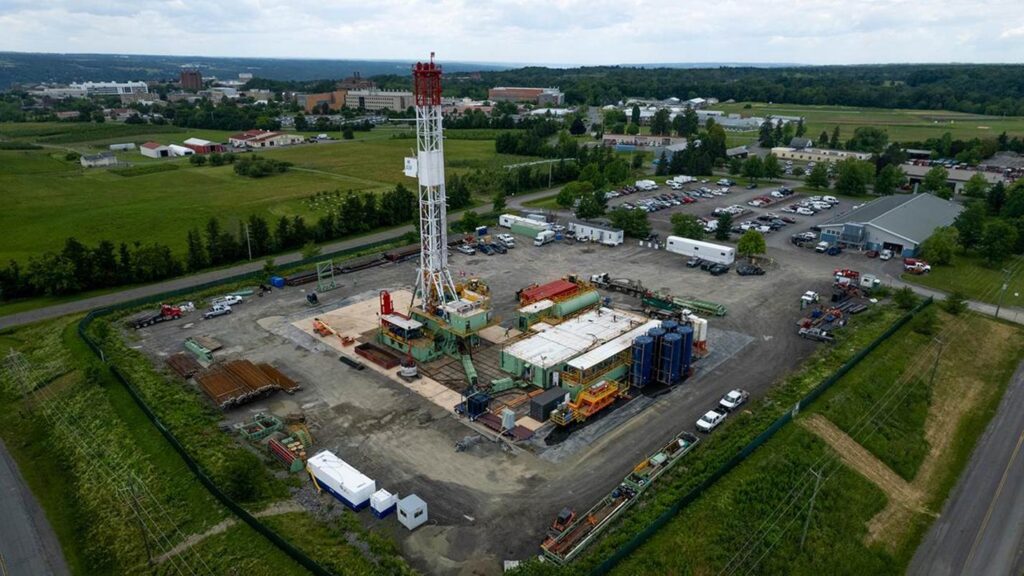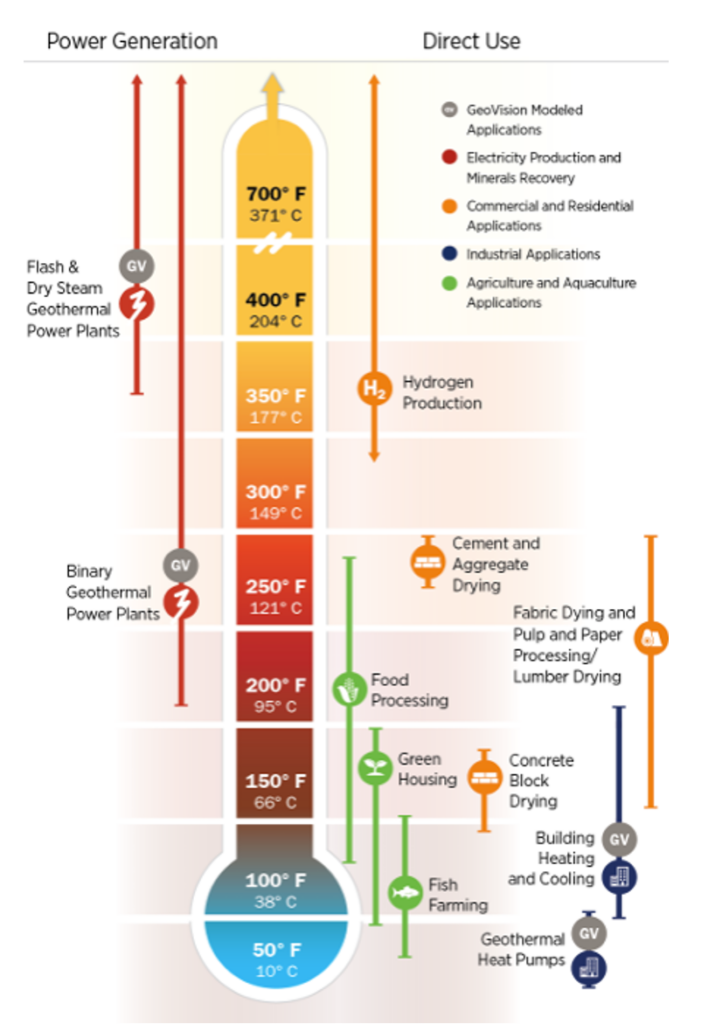Geothermal energy in the northeast is seeing technological developments led by Cornell University that may provide an alternative source of heat during this region’s bitterly cold winters.
Many cultures have harnessed geothermal energy for direct-use heating for centuries, using hot springs for bathing, cooking, and home heating. Today, as the United States navigates an energy transition, interest in direct-use geothermal heating is experiencing a renaissance, even in places far from tectonic boundaries. Recent work in Ithaca, New York, shows that the Northeast, though cooler and more geologically quiet than other parts of the United States, holds untapped heating potential just beneath its surface.
Key Takeaways:
- Cornell University drilled a 9,790-foot-deep borehole in 2022 to explore using direct-use geothermal heating for their campus buildings in Ithaca, New York.
- Direct-use geothermal heating uses thermal energy directly, without converting it into electricity (which would be less efficient). Underground heat can be used for space and water heating, greenhouse farming, aquaculture, milk pasteurization, and even to melt snow under roads and sidewalks.
- Many skills necessary to work in the oil and gas industries, such as modeling, drilling techniques, and instrumentation use, apply to geothermal development as well.
- The biggest barriers to scaling direct-use geothermal are a lack of investment in refining geothermal reservoir management techniques, improving subsurface mapping technologies, and developing better modeling tools.
For millennia, cultures around the world from China to Rome have harnessed the Earth’s natural heat by using hot springs for bathing, cooking, and home heating. Human beings have long recognized that geothermal energy is reliable and renewable, generating constant high temperatures year-round, 24/7.
A Deep Well of Opportunity in Ithaca, New York

Image: Cornell University’s 144-foot-tall geothermal drill rig. Source: Cornell Earth Source Heat
In 2022, Cornell University, supported by a $7.2 million Department of Energy grant, drilled a nearly two-mile-deep exploratory borehole beneath its Ithaca, New York, campus as part of its Earth Source Heat program. The project’s goal was to research the possibility of engineering a geothermal water reservoir to sustainably heat university buildings and help meet Cornell’s carbon neutrality target by 2035. Today, the team is continuing to study the safety and viability of earth source heat and is making plans for drilling a second well for a two-well earth source heat system.
While much of the United States’ focus on geothermal energy has centered around electricity generation in tectonically active regions, Cornell’s project highlights a different, highly promising application: direct-use geothermal heating. This approach could transform how the cold Northeastern states stay warm in the winter.
Why the Northeast Is a Great Fit for Direct-Use Geothermal
Most geothermal electricity plants in the United States are built near tectonic boundaries in California, Hawaii, Nevada, and Utah, where the crust is thinnest and subsurface temperatures are between 300° and 450° Fahrenheit relatively near the surface. These warm, sunny Western and Pacific states do not need help with heating most of the year, and so their geothermal heat is used to generate electricity. The combination of abundant heat, the development of tools and techniques for working in high temperatures, and the need for low-carbon electricity has resulted in a flourishing interest in geothermal electricity generation.
Unfortunately, geothermal electricity has a relatively low energy return on investment[1] of around nine-to-one, compared to about ten-to-one for solar, eighteen-to-one for wind, and eighty-four-to-one for hydropower. This means that geothermal electricity can be more costly and less efficient than other types of renewable electricity, especially when using lower-temperature underground water reserves. However, geothermal energy does have the added benefit that it is available all the time. By using lower-temperature geothermal reservoirs directly for heat rather than electricity generation, the efficiency of the process—and the energy return on investment—is greatly improved.
In the Northeast, geothermal wells can be drilled with widely available technology to reach temperatures in the 150° to 200° Fahrenheit range. “As the temperature goes down, the efficiency of converting the hot water to electricity falls off,” explains Jefferson Tester, a professor of sustainable energy systems at Cornell University and the lead scientist for Earth Source Heat. “If we tried to make electricity we would lose over ninety percent of that energy as waste heat … but if we use it directly as heat, we can use almost all of it because it’s sufficiently hot enough to warm buildings.”

Image: Geothermal temperatures and applied uses. Source: U.S. Department of Energy
Direct-use geothermal heating projects keep thermal energy in its most efficient form by using the underground heat for space and water heating, greenhouse farming, aquaculture, milk pasteurization, and even melting snow under roads and sidewalks. A typical geothermal heating system can support the water and indoor heating needs of buildings, campuses, and even entire communities, depending on the scale and efficiency of the system. As Wayne Bezner Kerr, the Earth Source Heat program manager, puts it, “It’s not a competition between geothermal for direct-use heat versus electricity.” Rather, the goal is to use the best local resource to meet local needs.
Geothermal Growth Is a Win for Jobs and Climate
Beyond its technical advantages, geothermal energy offers an opportunity for workforce transitions. Many skills from the oil and gas industries, such as modeling, drilling techniques, and instrumentation use, directly apply to geothermal development. Bezner Kerr emphasizes that “we cannot [develop geothermal] without the oil and gas workforce. Successful geothermal companies are already being led by people who come from oil and gas.”
Drilling rigs, which are expensive and privately owned by oil and gas companies, are readily available due to a pullback in oil production, Tester explained. If geothermal enterprises can work with drilling companies to coordinate equipment use and provide the capital to transport rigs, the drilling process can be made less costly.
So, the United States has unique advantages in deploying geothermal energy: a large, knowledgeable drilling workforce and idle equipment that can be repurposed for clean energy projects. Geothermal drilling gives workers new opportunities while supporting the growing demand for geothermal heating projects nationwide.
Bezner Kerr describes drilling for geothermal heat versus drilling for fossil fuels as “the difference between a community-managed woodlot and a clear-cut mountain. Both involve driving trucks full of saws and axes into the woods, but with geothermal, we’re building something sustainable for the long term.”
A Rare Opportunity, If Invested In
The biggest barrier to scaling direct-use geothermal is not the technology or workforce readiness. Rather, it is a lack of investment in refining geothermal reservoir management techniques, improving subsurface mapping technologies, and developing better modeling tools. Chloé Arson, a professor at Cornell University’s Department of Earth and Atmospheric Sciences, and a lead investigator for multiple enhanced geothermal research proposals, underscores the importance of broad-based investment, saying, “The idea of Cornell’s Earth Source Heat program is to have an impact not only on geoscience and engineering, but also on public policy, the economy, and ethics. Our best return on investment is education and research.”
Fortunately, there is momentum. Geothermal is receiving attention at the Department of Energy, including under initiatives such as the Enhanced Geothermal Earthshot[2]. Secretary of Energy Chris Wright recently acknowledged that while geothermal “hasn’t achieved liftoff yet, it should and it can.”
The Northeast is ripe for a clean heating revolution. Geothermal energy is available everywhere, and not just in tectonic hotspots. By tapping into local, low-temperature geothermal resources, communities can slash heating-related greenhouse gas emissions, create thousands of jobs, and transition toward a resilient, sustainable energy system.
About the Author: Whitney Orloff
Whitney Orloff was a Spring 2025 communications intern for Environmental and Energy Study Institute (EESI). She is a student at the University of Maryland-College Park majoring in environmental science and technology with a concentration in ecological technology design. She is also a certified scuba instructor and is excited to explore the intersections of science, policy, and community through EESI’s work in climate education.
Image: Shutterstock/Heru Fajar Fitriana
[1] Energy return on investment (EROI), often expressed as a ratio, can be defined as the amount of energy available for end use for every unit of energy needed during the generation process. For example, geothermal electricity generation, with a nine-to-one ratio, produces roughly nine units of available energy for every one unit of energy needed to make it. In the Northeast United States, using geothermal developments directly for heating can dramatically increase geothermal energy’s EROI compared to using the same resource to generate electricity
[2] Learn more about the Energy Earthshots from EESI’s briefing, Energy Earthshots: The Frontier of Climate Innovation, which included remarks from Rep. Frank Lucas (R-Okla.) on geothermal energy.













